height MAZDA MX-5 1997 Factory Repair Manual
[x] Cancel search | Manufacturer: MAZDA, Model Year: 1997, Model line: MX-5, Model: MAZDA MX-5 1997Pages: 514, PDF Size: 17.89 MB
Page 44 of 514
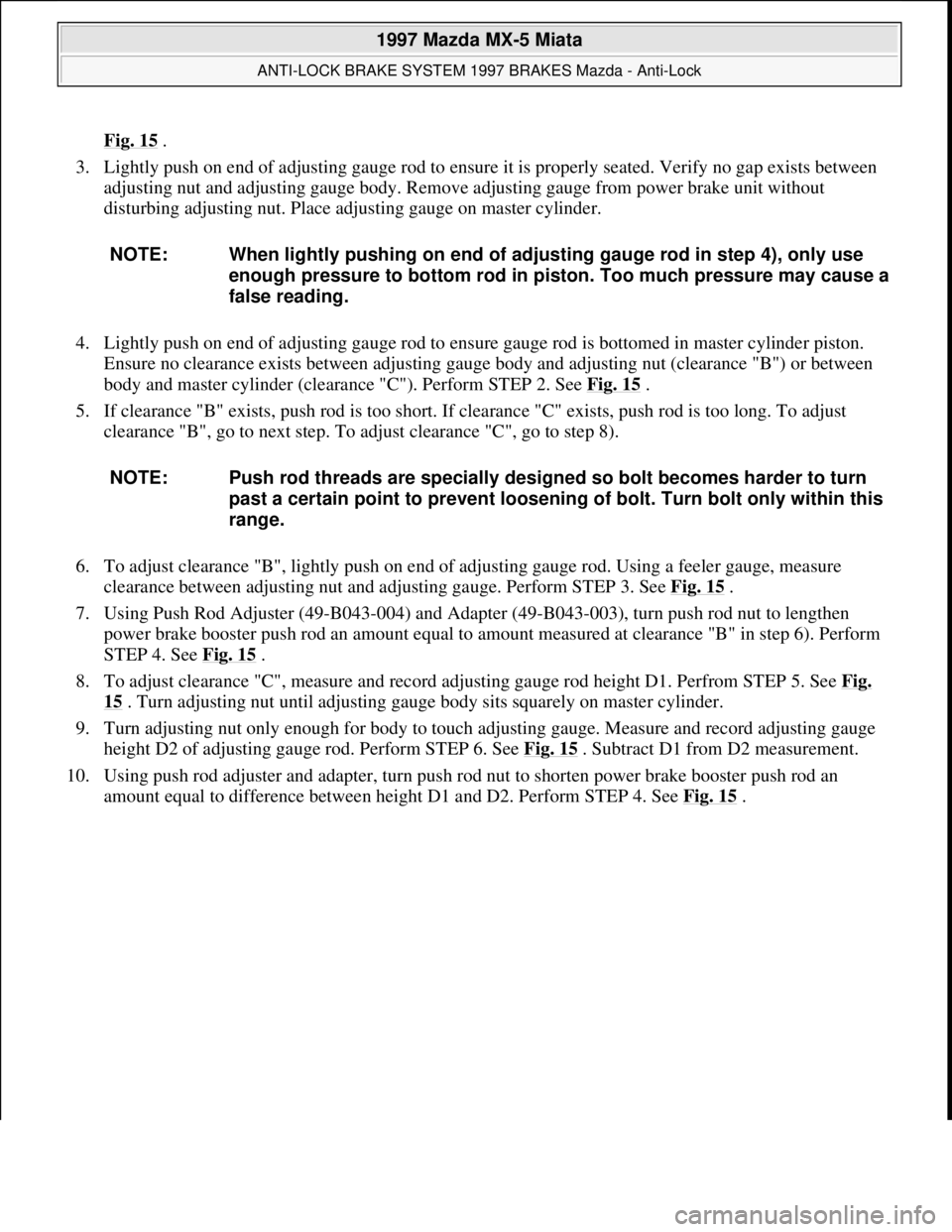
Fig. 15 .
3. Lightly push on end of adjusting gauge rod to ensure it is properly seated. Verify no gap exists between
adjusting nut and adjusting gauge body. Remove adjusting gauge from power brake unit without
disturbing adjusting nut. Place adjusting gauge on master cylinder.
4. Lightly push on end of adjusting gauge rod to ensure gauge rod is bottomed in master cylinder piston.
Ensure no clearance exists between adjusting gauge body and adjusting nut (clearance "B") or between
body and master cylinder (clearance "C"). Perform STEP 2. See Fig. 15
.
5. If clearance "B" exists, push rod is too short. If clearance "C" exists, push rod is too long. To adjust
clearance "B", go to next step. To adjust clearance "C", go to step 8).
6. To adjust clearance "B", lightly push on end of adjusting gauge rod. Using a feeler gauge, measure
clearance between adjusting nut and adjusting gauge. Perform STEP 3. See Fig. 15
.
7. Using Push Rod Adjuster (49-B043-004) and Adapter (49-B043-003), turn push rod nut to lengthen
power brake booster push rod an amount equal to amount measured at clearance "B" in step 6). Perform
STEP 4. See Fig. 15
.
8. To adjust clearance "C", measure and record adjusting gauge rod height D1. Perfrom STEP 5. See Fig.
15 . Turn adjusting nut until adjusting gauge body sits squarely on master cylinder.
9. Turn adjusting nut only enough for body to touch adjusting gauge. Measure and record adjusting gauge
height D2 of adjusting gauge rod. Perform STEP 6. See Fig. 15
. Subtract D1 from D2 measurement.
10. Using push rod adjuster and adapter, turn push rod nut to shorten power brake booster push rod an
amount equal to difference between hei
ght D1 and D2. Perform STEP 4. See Fig. 15 . NOTE: When lightly pushing on end of adjusting gauge rod in step 4), only use
enough pressure to bottom rod in piston. Too much pressure may cause a
false reading.
NOTE: Push rod threads are specially designed so bolt becomes harder to turn
past a certain point to prevent loosening of bolt. Turn bolt only within this
range.
1997 Mazda MX-5 Miata
ANTI-LOCK BRAKE SYSTEM 1997 BRAKES Mazda - Anti-Lock
Microsoft
Sunday, July 05, 2009 1:48:49 PMPage 23 © 2005 Mitchell Repair Information Company, LLC.
Page 45 of 514

Fig. 15: Adjusting Master Cylinder Push Rod
Courtesy of MAZDA MOTORS CORP.
BRAKE PEDAL HEIGHT & STOPLIGHT SWITCH
1. Released pedal height is measured from carpet surface, on vertical portion of firewall, to pedal pad center.
Disconnect stoplight switch electrical connector. Loosen lock nut on stoplight switch. Rotate switch away
from pedal. Loosen push rod lock nut. Rotate push rod until correct pedal height is as specified. See
BRAKE PEDAL HEIGHT SPECIFICATIONS
table.
2. Adjust pedal free play. See BRAKE PEDAL FREE PLAY
under ADJUSTMENTS. Tighten push rod
lock nut. Tighten push rod lock nut to 18-25 ft. lbs. (24-34 N.m).
3. Rotate stoplight switch until it contacts pedal, then rotate an additional 1/2 turn. Tighten stoplight switch
lock nut to 10-13 ft. lbs. (14-18 N.m). Reconnect stoplight switch electrical connector.
4. Applied pedal height is measured from angled portion of firewall (without carpet) to pedal pad center.
Start engine. Depress brake pedal with a pressure of 132 lbs. (60 kg).
5. Measure applied pedal height. See BRAKE PEDAL HEIGHT SPECIFICATIONS
table. If distance is
not as specified, check for air in system or worn pads. Repair as necessary.
BRAKE PEDAL HEIGHT SPECIFICATIONS
BRAKE PEDAL FREE PLAY
ApplicationIn. (mm)
Pedal Released6.8-7.1 (171-181)
Pedal Applied (1) 3.7 (95)
(1)Minimum height.
1997 Mazda MX-5 Miata
ANTI-LOCK BRAKE SYSTEM 1997 BRAKES Mazda - Anti-Lock
Microsoft
Sunday, July 05, 2009 1:48:49 PMPage 24 © 2005 Mitchell Repair Information Company, LLC.
Page 100 of 514
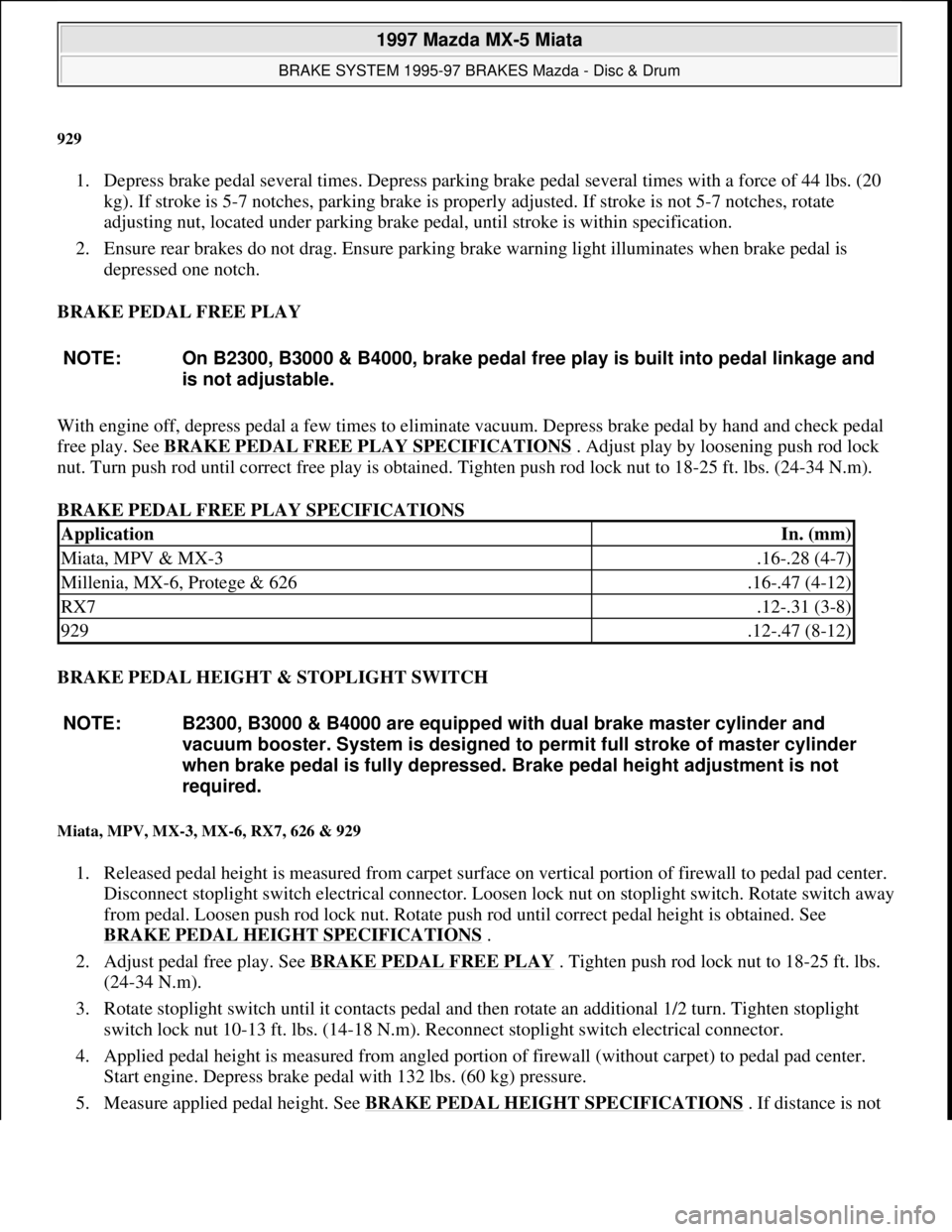
929
1. Depress brake pedal several times. Depress parking brake pedal several times with a force of 44 lbs. (20
kg). If stroke is 5-7 notches, parking brake is properly adjusted. If stroke is not 5-7 notches, rotate
adjusting nut, located under parking brake pedal, until stroke is within specification.
2. Ensure rear brakes do not drag. Ensure parking brake warning light illuminates when brake pedal is
depressed one notch.
BRAKE PEDAL FREE PLAY
With engine off, depress pedal a few times to eliminate vacuum. Depress brake pedal by hand and check pedal
free play. See BRAKE PEDAL FREE PLAY SPECIFICATIONS
. Adjust play by loosening push rod lock
nut. Turn push rod until correct free play is obtained. Tighten push rod lock nut to 18-25 ft. lbs. (24-34 N.m).
BRAKE PEDAL FREE PLAY SPECIFICATIONS
BRAKE PEDAL HEIGHT & STOPLIGHT SWITCH
Miata, MPV, MX-3, MX-6, RX7, 626 & 929
1. Released pedal height is measured from carpet surface on vertical portion of firewall to pedal pad center.
Disconnect stoplight switch electrical connector. Loosen lock nut on stoplight switch. Rotate switch away
from pedal. Loosen push rod lock nut. Rotate push rod until correct pedal height is obtained. See
BRAKE PEDAL HEIGHT SPECIFICATIONS
.
2. Adjust pedal free play. See BRAKE PEDAL FREE PLAY
. Tighten push rod lock nut to 18-25 ft. lbs.
(24-34 N.m).
3. Rotate stoplight switch until it contacts pedal and then rotate an additional 1/2 turn. Tighten stoplight
switch lock nut 10-13 ft. lbs. (14-18 N.m). Reconnect stoplight switch electrical connector.
4. Applied pedal height is measured from angled portion of firewall (without carpet) to pedal pad center.
Start engine. Depress brake pedal with 132 lbs. (60 kg) pressure.
5. Measure applied pedal hei
ght. See BRAKE PEDAL HEIGHT SPECIFICATIONS . If distance is not NOTE: On B2300, B3000 & B4000, brake pedal free play is built into pedal linkage and
is not adjustable.
ApplicationIn. (mm)
Miata, MPV & MX-3.16-.28 (4-7)
Millenia, MX-6, Protege & 626.16-.47 (4-12)
RX7.12-.31 (3-8)
929.12-.47 (8-12)
NOTE: B2300, B3000 & B4000 are equipped with dual brake master cylinder and
vacuum booster. System is designed to permit full stroke of master cylinder
when brake pedal is fully depressed. Brake pedal height adjustment is not
required.
1997 Mazda MX-5 Miata
BRAKE SYSTEM 1995-97 BRAKES Mazda - Disc & Drum
Microsoft
Sunday, July 05, 2009 1:51:02 PMPage 6 © 2005 Mitchell Repair Information Company, LLC.
Page 101 of 514
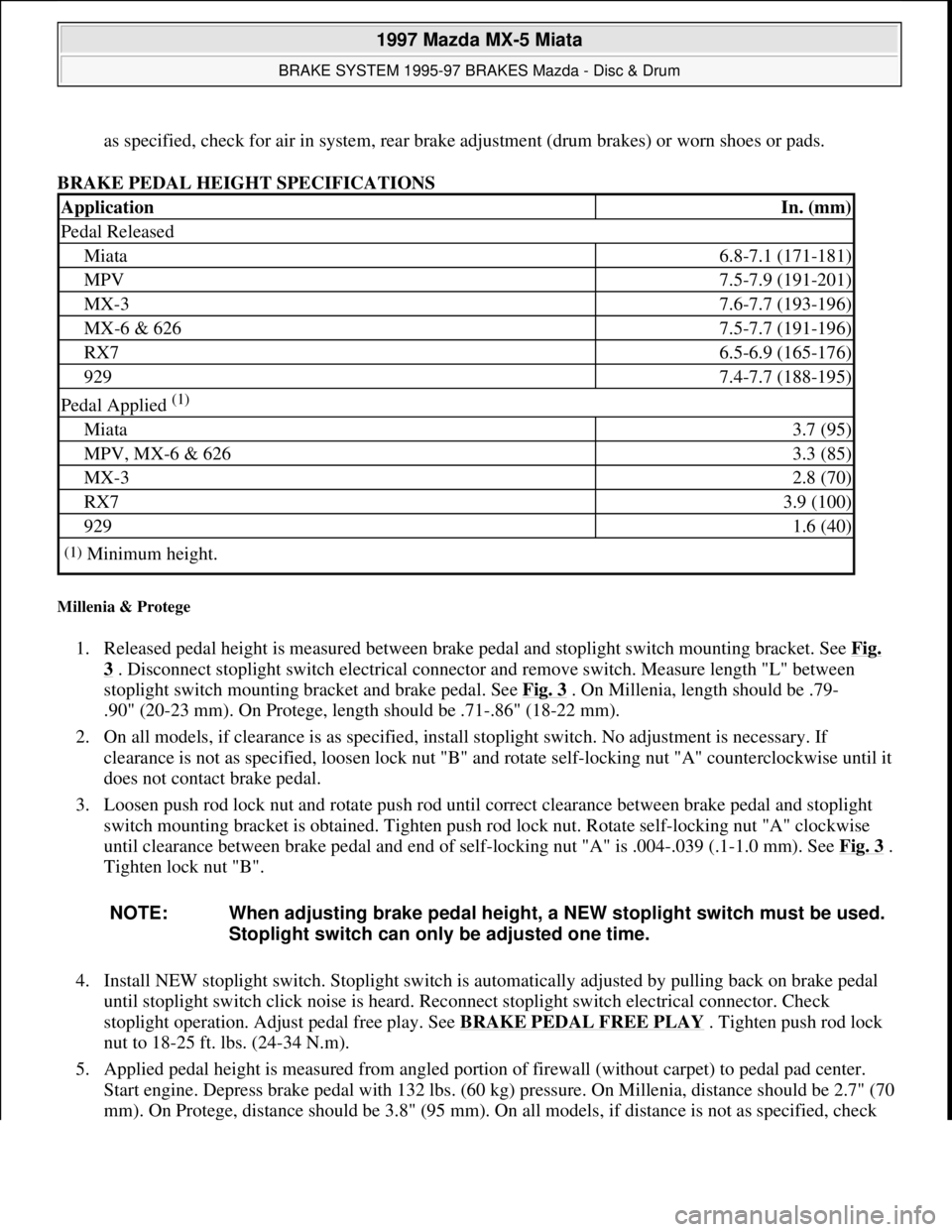
as specified, check for air in system, rear brake adjustment (drum brakes) or worn shoes or pads.
BRAKE PEDAL HEIGHT SPECIFICATIONS
Millenia & Protege
1. Released pedal height is measured between brake pedal and stoplight switch mounting bracket. See Fig.
3 . Disconnect stoplight switch electrical connector and remove switch. Measure length "L" between
stoplight switch mounting bracket and brake pedal. See Fig. 3
. On Millenia, length should be .79-
.90" (20-23 mm). On Protege, length should be .71-.86" (18-22 mm).
2. On all models, if clearance is as specified, install stoplight switch. No adjustment is necessary. If
clearance is not as specified, loosen lock nut "B" and rotate self-locking nut "A" counterclockwise until it
does not contact brake pedal.
3. Loosen push rod lock nut and rotate push rod until correct clearance between brake pedal and stoplight
switch mounting bracket is obtained. Tighten push rod lock nut. Rotate self-locking nut "A" clockwise
until clearance between brake pedal and end of self-locking nut "A" is .004-.039 (.1-1.0 mm). See Fig. 3
.
Tighten lock nut "B".
4. Install NEW stoplight switch. Stoplight switch is automatically adjusted by pulling back on brake pedal
until stoplight switch click noise is heard. Reconnect stoplight switch electrical connector. Check
stoplight operation. Adjust pedal free play. See BRAKE PEDAL FREE PLAY
. Tighten push rod lock
nut to 18-25 ft. lbs. (24-34 N.m).
5. Applied pedal height is measured from angled portion of firewall (without carpet) to pedal pad center.
Start engine. Depress brake pedal with 132 lbs. (60 kg) pressure. On Millenia, distance should be 2.7" (70
mm). On Protege, distance should be 3.8" (95 mm). On all models, if distance is not as specified, check
ApplicationIn. (mm)
Pedal Released
Miata6.8-7.1 (171-181)
MPV7.5-7.9 (191-201)
MX-37.6-7.7 (193-196)
MX-6 & 6267.5-7.7 (191-196)
RX76.5-6.9 (165-176)
9297.4-7.7 (188-195)
Pedal Applied (1)
Miata3.7 (95)
MPV, MX-6 & 6263.3 (85)
MX-32.8 (70)
RX73.9 (100)
9291.6 (40)
(1)Minimum height.
NOTE: When adjusting brake pedal height, a NEW stoplight switch must be used.
Stoplight switch can only be adjusted one time.
1997 Mazda MX-5 Miata
BRAKE SYSTEM 1995-97 BRAKES Mazda - Disc & Drum
Microsoft
Sunday, July 05, 2009 1:51:02 PMPage 7 © 2005 Mitchell Repair Information Company, LLC.
Page 102 of 514
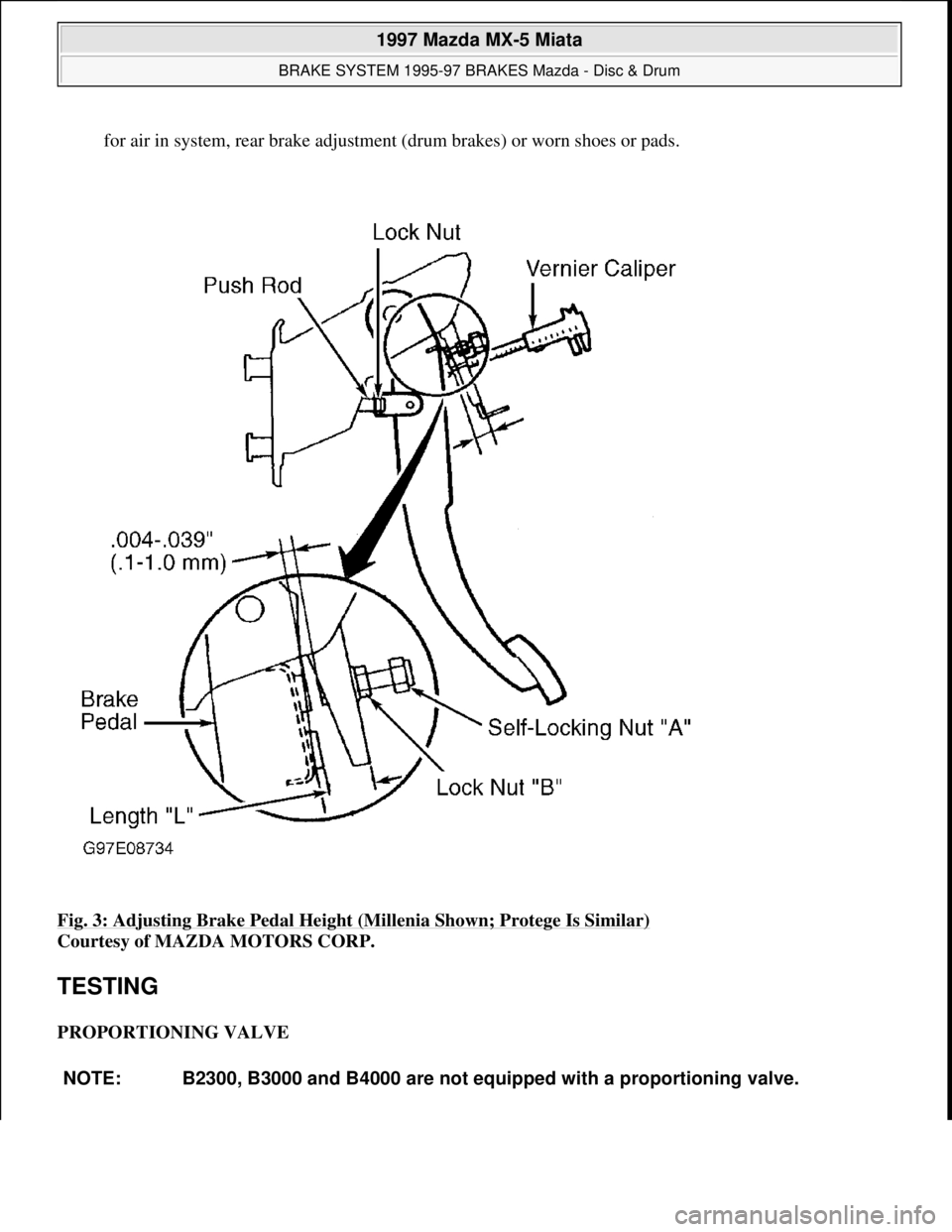
for air in system, rear brake adjustment (drum brakes) or worn shoes or pads.
Fig. 3: Adjusting Brake Pedal Height (Millenia Shown; Protege Is Similar)
Courtesy of MAZDA MOTORS CORP.
TESTING
PROPORTIONING VALVE
NOTE: B2300, B3000 and B4000 are not equipped with a proportioning valve.
1997 Mazda MX-5 Miata
BRAKE SYSTEM 1995-97 BRAKES Mazda - Disc & Drum
Microsoft
Sunday, July 05, 2009 1:51:03 PMPage 8 © 2005 Mitchell Repair Information Company, LLC.
Page 104 of 514

POWER BRAKE UNIT
1. With engine off, depress brake pedal several times. Press and hold brake pedal and start engine. If brake
pedal moves down slightly immediately after engine starts, power brake unit is operating. If brake pedal
does not move as specified, go to next step.
2. Run engine for 1-2 minutes. Stop engine. Press brake pedal several times and note if first pedal stroke is
longer than subsequent strokes. If first pedal stroke is longer than subsequent strokes, power brake unit is
operating. If length of strokes is equal, check valve and vacuum hose between vacuum source and power
brake unit. Repair as necessary, and go to next step.
3. Start engine. Press and hold brake pedal. Stop engine. Hold pedal down for about 30 seconds. If pedal
height remains at same height, power brake unit is operating. If pedal height recedes, check valve and
vacuum hose between vacuum source and power brake unit. Repair as necessary.
REMOVAL & INSTALLATION
FRONT DISC BRAKE PADS
Removal & Installation (B2300, B3000 & B4000)
1. To prevent master cylinder overflow when caliper piston is depressed, remove and discard some brake
fluid from master cylinder reservoir. Raise and support vehicle. Remove front wheel assemblies. Place a
large "C" clamp on caliper.
2. Tighten clamp to bottom piston in cylinder bore. Remove clamp. Remove 2 caliper pin bolts. Remove
caliper from rotor and wire aside. Slide brake pads off caliper anchor plate. Remove anchor plate (if
necessary). Replace pad if lining thickness is less than specified. See MINIMUM PAD LINING
SPECIFICATIONS (FRONT) .
3. To install, reverse removal procedure. Use "C" clamp and old pad to push caliper piston into piston bore
until piston bottoms out. Bleed air from brake system (if necessary).
Removal & Installation (Miata, Millenia, MPV, MX-6, 626 & 929)
1. Raise and support front of vehicle. Remove front wheel assemblies. Remove lower lock pin/guide bolt.
See Fig. 4
, Fig. 5 or Fig. 6 . Pivot caliper upward and support using rope.
2. Remove pads, shims, guide plates or pad guides and "V" springs (if equipped). Replace pad if lining
thickness is less than specified. See MINIMUM PAD LINING SPECIFICATIONS (FRONT)
.
3. To install, reverse removal procedure. Use Disc Brake Expander (49-0221-600C) and an old pad to push
piston full
y inward to install disc pads.
(38-46)
1997 Mazda MX-5 Miata
BRAKE SYSTEM 1995-97 BRAKES Mazda - Disc & Drum
Microsoft
Sunday, July 05, 2009 1:51:03 PMPage 10 © 2005 Mitchell Repair Information Company, LLC.
Page 157 of 514
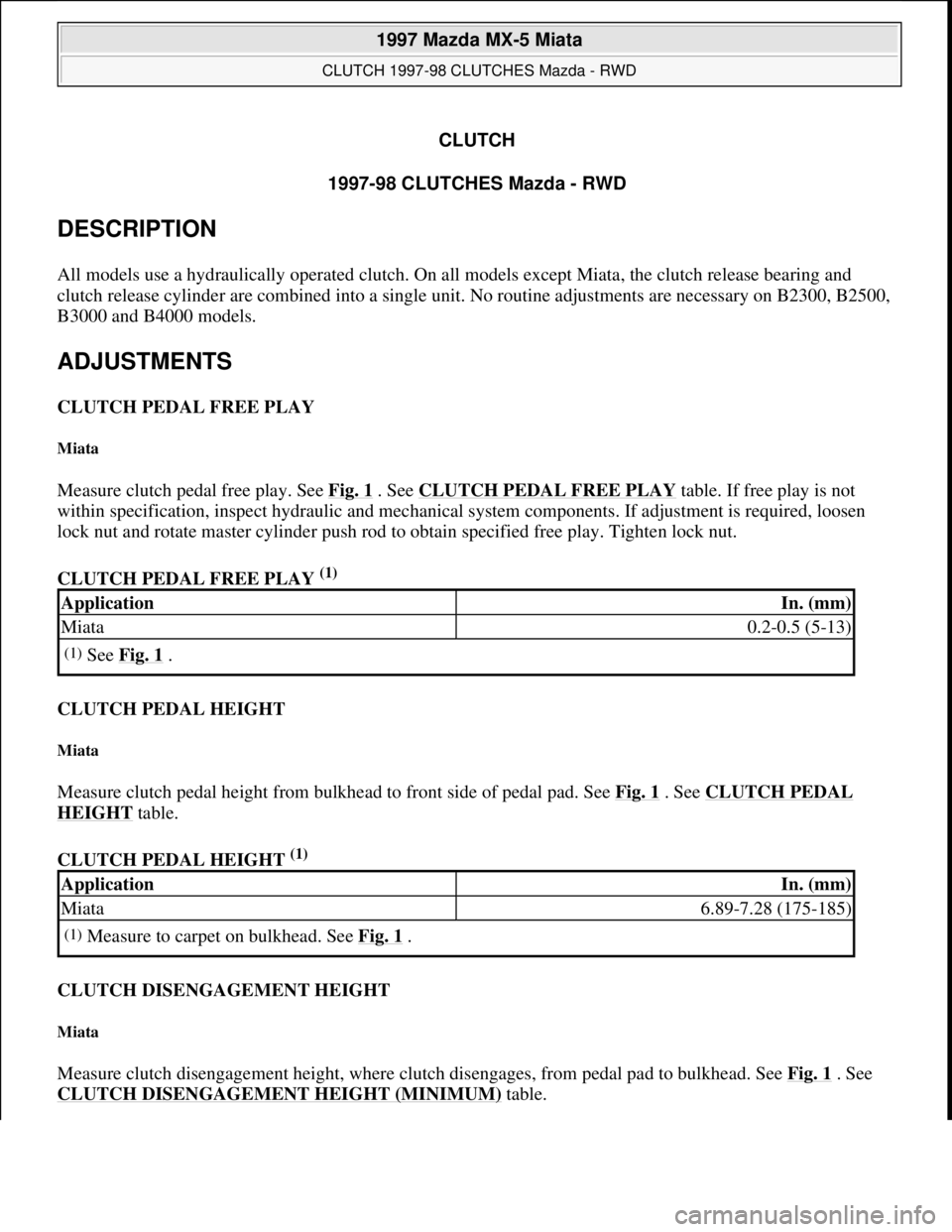
CLUTCH
1997-98 CLUTCHES Mazda - RWD
DESCRIPTION
All models use a hydraulically operated clutch. On all models except Miata, the clutch release bearing and
clutch release cylinder are combined into a single unit. No routine adjustments are necessary on B2300, B2500,
B3000 and B4000 models.
ADJUSTMENTS
CLUTCH PEDAL FREE PLAY
Miata
Measure clutch pedal free play. See Fig. 1 . See CLUTCH PEDAL FREE PLAY table. If free play is not
within specification, inspect hydraulic and mechanical system components. If adjustment is required, loosen
lock nut and rotate master cylinder push rod to obtain specified free play. Tighten lock nut.
CLUTCH PEDAL FREE PLAY
(1)
CLUTCH PEDAL HEIGHT
Miata
Measure clutch pedal height from bulkhead to front side of pedal pad. See Fig. 1 . See CLUTCH PEDAL
HEIGHT table.
CLUTCH PEDAL HEIGHT
(1)
CLUTCH DISENGAGEMENT HEIGHT
Miata
Measure clutch disengagement height, where clutch disengages, from pedal pad to bulkhead. See Fig. 1 . See
CLUTCH DISENGAGEMENT HEIGHT (MINIMUM)
table.
ApplicationIn. (mm)
Miata0.2-0.5 (5-13)
(1)See Fig. 1 .
ApplicationIn. (mm)
Miata6.89-7.28 (175-185)
(1)Measure to carpet on bulkhead. See Fig. 1 .
1997 Mazda MX-5 Miata
CLUTCH 1997-98 CLUTCHES Mazda - RWD
1997 Mazda MX-5 Miata
CLUTCH 1997-98 CLUTCHES Mazda - RWD
Microsoft
Sunday, July 05, 2009 1:36:47 PMPage 1 © 2005 Mitchell Repair Information Company, LLC.
Microsoft
Sunday, July 05, 2009 1:36:51 PMPage 1 © 2005 Mitchell Repair Information Company, LLC.
Page 158 of 514

CLUTCH DISENGAGEMENT HEIGHT (MINIMUM) (1)
Fig. 1: Adjusting Clutch Pedal (Miata)
Courtesy of MAZDA MOTORS CORP.
HYDRAULIC SYSTEM BLEEDING
B2300, B2500, B3000 & B4000
ApplicationIn. (mm)
Miata2.68 (68)
(1)Measure to carpet on bulkhead. See Fig. 1 .
1997 Mazda MX-5 Miata
CLUTCH 1997-98 CLUTCHES Mazda - RWD
Microsoft
Sunday, July 05, 2009 1:36:47 PMPage 2 © 2005 Mitchell Repair Information Company, LLC.
Page 194 of 514

Fig. 12: Checking Drive Pinion Installation & Position
Courtesy of MAZDA MOTORS CORP.
6. Install dial indicator on Pinion Height Gauge (49-0727-570). Place pinion height gauge on a flat surface
and zero dial indicator. Position gauge block on top of dummy drive pinion assembly. See GAUGE
BLOCK SELECTION table.
GAUGE BLOCK SELECTION
7. Place pinion height gauge on top of gauge block. Position dial indicator to measure distance to a point
where side bearing sits. Measure lowest point. See Fig. 12
. Measure both sides. Add both measurements
together and divide by 2.
8. If result is not zero, replace pinion spacer. Spacers are available in a range of .1213-.1366" (3.080-3.470
mm) in .001" (.03 mm) increments. Remove dummy drive pinion. Press rear bearing onto drive pinion.
9. Install drive pinion, spacer, front bearing, collapsible spacer and companion flange in differential carrier.
DO NOT install pinion oil seal yet. DO NOT exceed one-ton force; collapsible spacer will be damaged.
10. Install washer and drive pinion lock nut. Temporarily tighten drive pinion lock nut. Turn companion
flange by hand to seat bearing. Using torque wrench, tighten drive pinion lock nut to specification. See
TORQUE SPECIFICATIONS
. Check pinion bearing preload at drive pinion lock nut. See PINION
PRELOAD SPECIFICATIONS table. If pinion bearing preload is not as specified, replace collapsible
spacer and recheck preload.
PINION PRELOAD SPECIFICATIONS
11. Remove drive pinion lock nut, washer and companion flange. Install pinion oil seal. Lubricate oil seal lip
with differential oil. Install companion flange and washer. Install NEW drive pinion lock nut and tighten
to specification. See TORQUE SPECIFICATIONS
. Recheck pinion bearing preload. Lubricate end of
companion flange with grease.
12. Position differential assembly into differential carrier. Install side bearing adjusters. Position side bearing
caps. Align marks made during disassembly. Install side bearing cap bolts and hand-tighten bolts.
13. Ti
ghten side bearing adjusters equally until adjusters contact bearing races. Mark ring gear in 4 locations,
ApplicationGauge Block No.
Front Differential
MPV
4WD49-0305-555
Rear Differential
Miata49-0305-555
MPV49-0660-555
ApplicationINCH Lbs. (N.m)
Miata7.8-12.1 (0.9-1.3)
MPV 2WD11.3-15.6 (1.3-1.8)
MPV 4WD
Front7.8-12.2 (0.9-1.4)
Rear11.3-15.6 (1.3-1.8)
1997 Mazda MX-5 Miata
1997-98 DRIVE AXLES Differentials & Drive Axles - MPV & MX-5 Miata
Microsoft
Sunday, July 05, 2009 1:52:42 PMPage 20 © 2005 Mitchell Repair Information Company, LLC.
Page 229 of 514

Courtesy of MAZDA MOTORS CORP.
Removal & Installation (Protege)
1. Disconnect negative battery cable. Remove engine undercovers. Drain engine oil. Remove exhaust header
downpipe and brackets from front exhaust system. Remove oil pan retaining bolts.
2. DO NOT damage sealant contact surfaces. Remove oil pan by prying between oil pan and mounting
surface. On Protege, remove stiffener by prying between stiffener and cylinder block. On all models,
clean all sealant from oil pan, bolts, engine block and both sides of stiffener (Protege).
3. On Protege, apply oil resistant sealant to engine block and stiffener. Install stiffener. On all models, apply
sealant and install oil pan within 5 minutes of applying sealant. To complete installation, reverse removal
procedure. Tighten all bolts to specification. See TORQUE SPECIFICATIONS
. Fill engine with oil to
specification. See ENGINE LUBRICATION SYSTEM
under ENGINE OILING.
OVERHAUL
CYLINDER HEAD
Cylinder Head
Clean carbon and gasket material from all mating surfaces. Using a tap, clean cylinder head threads. Check
cylinder head warpage. If warpage exceeds specification, resurface head, but DO NOT exceed grinding limit.
See CYLINDER HEAD
under ENGINE SPECIFICATIONS. After resurfacing cylinder head, check cylinder
head height. Replace cylinder head if height is less than minimum specification.
Valve Springs
Ensure valve spring free length, out-of-square and compressed length are within specification. See VALVES &
VALVE SPRINGS under ENGINE SPECIFICATIONS. Replace valve spring if necessary.
Valve Stem Oil Seals
1. On Miata, use Installer Set (49-L012-0A0) to install valve seals. See Fig. 15 . Adjust installer dimension
"L" to seal depth of .720-.744" (18.3-18.9 mm). Using hand pressure ONLY, install seal until it contacts
cylinder head. Lightly oil valve seal lip.
2. On Protege, use Installer Set (49-L012-0A0) to install valve seals. See Fig. 15
. Adjust installer
dimension "L" to seal depth of .783" (19.9 mm). Using hand pressure, install seal until it contacts cylinder CAUTION: If reusing old oil pan bolts, remove old sealant from bolt threads.
Failure to remove old sealant may result in cracked block at bolt
holes.
NOTE: Intake and exhaust valve stem seals are different. Exhaust seals can be
identified by ridges molded into top of seal. Intake seals do not have identifying
ridges. Incorrect installation of valve stem seals will cause premature failure.
1997 Mazda MX-5 Miata
1997-98 ENGINES 1.8L 4-Cylinder
Microsoft
Sunday, July 05, 2009 1:55:15 PMPage 23 © 2005 Mitchell Repair Information Company, LLC.